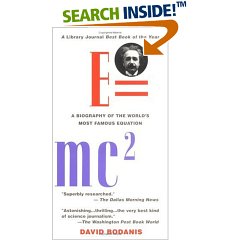
Mention the name of Albert Einstein, and it’s likely that one of two images will come to mind: one of a bemused, slightly disheveled genius-next-door, or the serious scientist, calmly explaining seemingly simple equations that would befuddle mere mortals. The complexities of Einstein’s character and the incredible impact his work has had on the world has been documented many times over, making one of the most familiar figures not just in science, but in all of history.
It’s not surprising that with so much ink already spilled on Einstein’s life that authors would be taking different approaches to the man and his work. David Bodanis’ wonderful E=mc²: A Biography of the World’s Most Famous Equation is an example of a smart, approachable work as entertaining as it is informative. Einstein himself is only a small part of the book: Bodanis traces all aspects of the equation from their origin to their dramatic, sometimes fearful application. So we learn how Voltaire’s mistress laid the groundwork for c², why a winter stroll through Sweden’s woods would lead to the horrors of Hiroshima and how an Indian scientist could begin to imagine a mind-boggling phenomenon we now know as a black hole. The only quibble I have with Bodanis’ text is that it doesn’t include footnotes for the 70-odd pages of notes, but astute readers can catch up with those at the end of chapters. For the layman or for the scientist, E=mc² provides a fascinating, all-encompassing history, and proves how Einstein’s brilliant equation has taken on such a life of its own.
 Michael Paterniti takes an entirely different approach to Einstein’s legacy in his Driving Mr. Albert: A Trip Across America With Einstein’s Brain. The title is not simply a cute attention getting device: Paterniti’s memoir/travelogue recounts his actual experience driving the pathologist who performed Einstein’s autopsy across the country, with the famous brain sloshing around in a Tupperware container in the trunk. The story of how the gray matter got there is a weird tale, focusing mostly on the oddball pathologist who had custody of the brain and his dubious attempts to study it. Paterniti also muses on the meaning of genius—whether it can be tangeable like chunks of brain or if it really comes down how society decides to perceive an individual. Unfortunately, Paterniti also chooses to meditate on the state of his relationship during the course of the road trip. This and some rehashed material makes it feel like Driving Mr. Albert was fleshed out to get it to book length (it started life as a Harper’s Magazine article). Driving Mr. Albert got a number of rave reviews when it was first published in 2000, but in spite of it’s promising material, never seems to get beyond the musing stages. Even with his brain close at hand, the key to understanding Einstein’s genius remains tantalizingly out of reach.
Michael Paterniti takes an entirely different approach to Einstein’s legacy in his Driving Mr. Albert: A Trip Across America With Einstein’s Brain. The title is not simply a cute attention getting device: Paterniti’s memoir/travelogue recounts his actual experience driving the pathologist who performed Einstein’s autopsy across the country, with the famous brain sloshing around in a Tupperware container in the trunk. The story of how the gray matter got there is a weird tale, focusing mostly on the oddball pathologist who had custody of the brain and his dubious attempts to study it. Paterniti also muses on the meaning of genius—whether it can be tangeable like chunks of brain or if it really comes down how society decides to perceive an individual. Unfortunately, Paterniti also chooses to meditate on the state of his relationship during the course of the road trip. This and some rehashed material makes it feel like Driving Mr. Albert was fleshed out to get it to book length (it started life as a Harper’s Magazine article). Driving Mr. Albert got a number of rave reviews when it was first published in 2000, but in spite of it’s promising material, never seems to get beyond the musing stages. Even with his brain close at hand, the key to understanding Einstein’s genius remains tantalizingly out of reach.
.jpg)
No comments:
Post a Comment